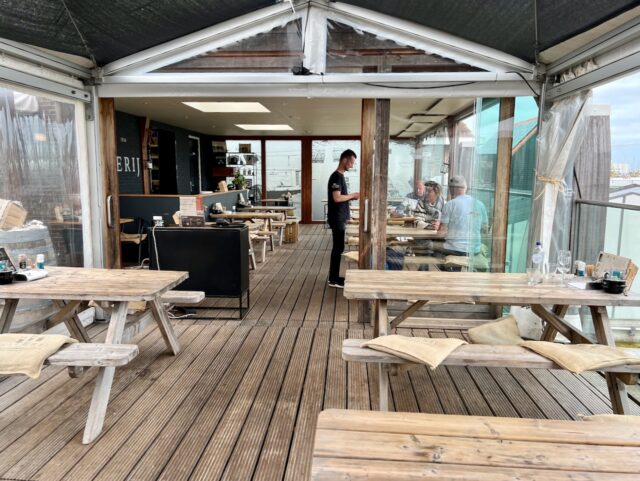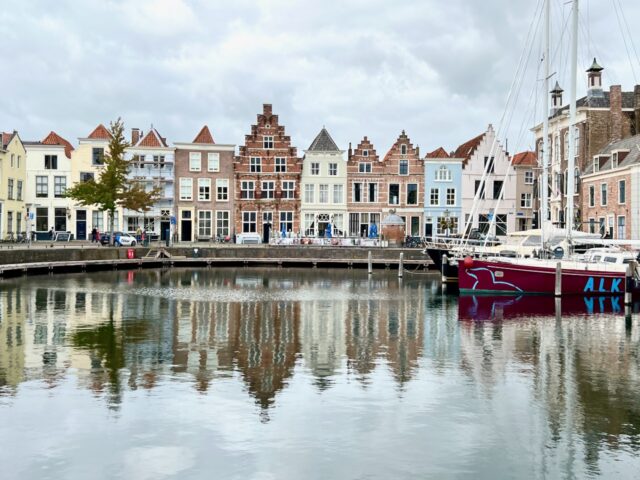Nestled in the heart of the picturesque province of Zeeland in the Netherlands lies Yerseke (map), a charming village with a rich maritime heritage and which is especially renowned for its prized oysters and mussels. As a fan of these mollusks, I was excited to include Yerseke, the oyster capital of The Netherlands, in my road trip around Zeeland. With its serene coastal setting and numerous seafood-related activities, I knew that Yerseke would be a fabulous treat. And it was!


The Oyster and Mussel Farms in Yerseke
Yerseke’s claim to fame is undoubtedly its thriving oyster and mussel industry. The village is home to numerous oyster and mussel farms, so one of the first things I did was to tour one of these farms, specifically the Oesterij.


This farm, located at the harbour front, offers oyster and mussel tastings at its two restaurants as well as guided tours and an informative museum. Touring the farm was a great way to witness firsthand the meticulous care and craftsmanship that goes into cultivating these mollusks.

Oyster-tasting in Yerseke
A trip to Yerseke would be incomplete without savouring the exquisite taste of fresh oysters (and mussels). After the oyster farm tour, I got to have my first taste of the delicious oysters. Gosh, they were sublime! I greedily ordered more of the local variety, Zeeuwse Creuse, as well as a mix of different oyster varieties, and paired them with a crisp Sauvignon Blanc. The combination of briny sea flavours and the idyllic waterfront setting made for a simply heavenly culinary experience.


The Oesterfestival (Oyster Festival)
The oyster season in Zeeland kicks of in late-September and to celebrate this, the Oesterfestival (Oyster Festival) is organised every year in October. This 3-day oyster extravaganza features many oyster-tasting opportunities, guided tours and lots of food and drinks.
Where to eat in Yerseke
Being the oyster capital of the Netherlands with a famous seafood industry, Yerseke boasts a good variety of eateries, from simple seafood kiosks at the harbour to high-end seafood restaurants. In addition to the Oesterij at the harbour, my seafood splurge in Yerseke also included Oesterput 14, De Viskêête (both at the harbour) and the top-notch Oesterbeurs restaurant in the village centre.





How to get to Yerseke
It’s a bit of a challenge to get to Yerseke with public transport from cities in the north like Amsterdam or Rotterdam. Depending on the time of day, it can take between 2.5 and 3.5 hours to get to Yerseke from Amsterdam, a journey that involves changing trains and reaching Yerseke by bus. By car, it’s a bit more than 2 hours from Amsterdam, and 1+ hour from Rotterdam. Search for rental cars.
When to visit Yerseke
The best time to visit Yerseke largely depends on your seafood preferences and whether you’d like to experience specific events:
Summer
June to September is ideal for pleasant weather and enjoying the outdoor ambiance of Yerseke. Oysters and mussels are still available during this time, and you can enjoy them in the open-air seafood restaurants.
Oyster season
To witness the oyster harvest and farming activities at their peak, visit from late autumn to early spring. An easy way to remember when the oyster season (or mussels for that matter) is: months with the letter ‘R’ (i.e. September till April). The Oyster Festival is typically held in October.
Where to stay in Yerseke
Yerseke is small so there’s a limited number of accommodation options in the village. I stayed at the wonderful Sint Anna B&B Petit Hotel. This B&B is located in a converted church and features spacious rooms and bathrooms, and a delicious breakfast spread. The owners, Meinte and Maartje, also organise oyster tours and tastings for their guests.


Yerseke is a captivating destination that combines seafood indulgence with natural beauty. Whether you’re a seafood connoisseur or simply seeking a tranquil getaway by the sea, Yerseke in Zeeland, Netherlands, promises a delightful experience you won’t soon forget. I know I won’t!
Places to visit around Yerseke
During my visit to Yerseke, I also had the opportunity to explore the surrounding area. Two places I visited were:
Yerseke Moer
For those interested in the natural beauty of the area, Yerseke Moer is a must-visit. This nature reserve just outside Yerseke (map) forms a stark contrast to the bustling seafood industry. There are walking paths which made it easy to appreciate the flora and fauna, including a great variety of bird life, in the salt marshes and tidal flats. It’s a peaceful retreat that provides a glimpse into the natural landscape of Zeeland.
Goes
The largest town in the area is Goes, an absolute gem. Goes (map) was founded in the 10th century and grew into an important regional centre with medieval fortifications. These days, it’s a bustling town with numerous historic attractions as well as a plethora of shops, restaurants and cafés.

I recommend a visit to the 12th century Mary Magdalene Church (volunteer guides in the church provide a fascinating commentary of the history of the church), the Grote Markt (or main square) and the picturesque Stadshaven (town harbour).



I also suggest having lunch or a drink at Slot Oostende (Oostende Castle), opposite the Mary Magdalene Church. This 13th century castle is now a café/restaurant, hotel and brewery.
Other nearby towns I recommend for a visit include Middelburg and Bergen Op Zoom, which feature on my list of most beautiful towns in the Netherlands.












